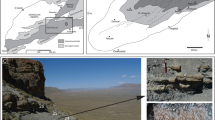Abstract
VARIOUS shell bodies exist in the chenier plain facies of east Essex1,2. Offshore banks are one of the more prominent types, and within these banks there is often a pronounced vertical imbrication in the surface layer of shells (Fig. 1). This exerts a stabilizing influence on the movement of the shells and shell bodies retarding, though not preventing, long term migration. Imbrication has not yet been observed in deposits of the inshore zone.
Similar content being viewed by others
References
Greensmith, J. T., and Tucker, E. V., Proc. Geol. Assoc., 77, 329 (1966).
Greensmith, J. T., and Tucker, E. V., Marine Geology (in the press).
Talbot, J. W., Fish. Invest., Series II, 25 (Ministry of Agriculture and Fisheries, 1967).
Seilacher, A., and Meischner, D., Geol. Rundschau, 54, 596 (1965).
Author information
Authors and Affiliations
Rights and permissions
About this article
Cite this article
GREENSMITH, J., TUCKER, E. Imbricate Structure in Essex Offshore Shell Banks. Nature 220, 1115–1116 (1968). https://doi.org/10.1038/2201115a0
Received:
Revised:
Issue Date:
DOI: https://doi.org/10.1038/2201115a0
- Springer Nature Limited
This article is cited by
-
Autochthonous to parautochthonous bivalve concentrations within transgressive marginal marine strata of the Upper Jurassic of Portugal
Palaeobiodiversity and Palaeoenvironments (2009)





